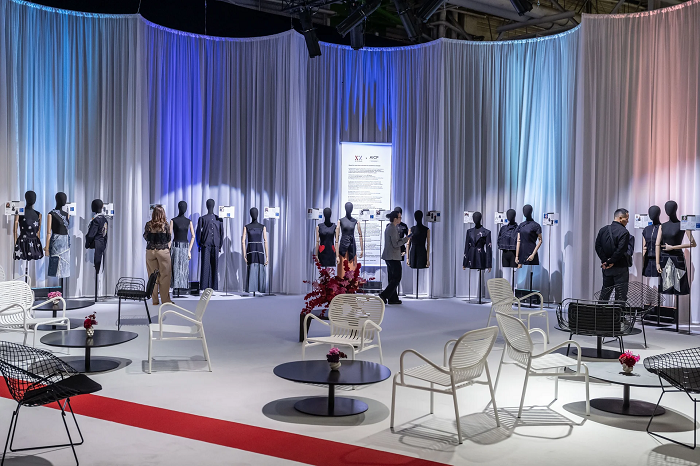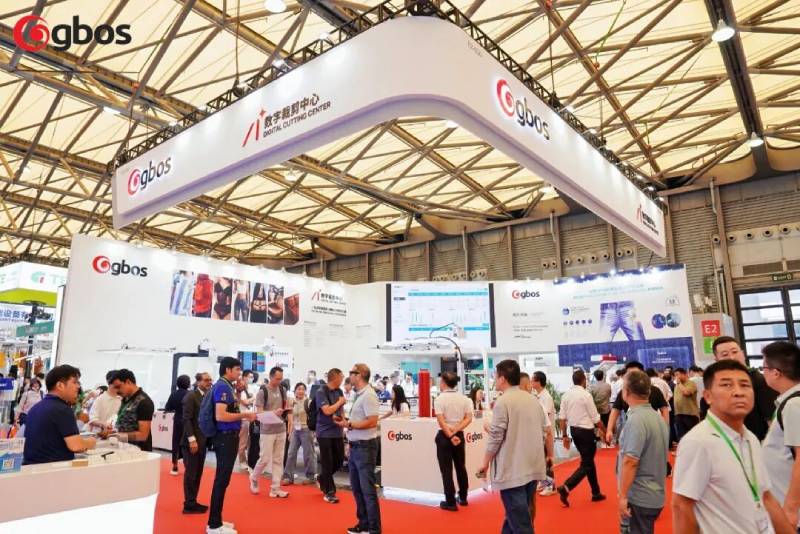
Mitsubishi Rayon Group, a renowned synthetic acrylic and acetate fibre manufacturer develops polyester fibre and polypropylene fibre for carpet, clothing products etc. It has recently launched a unique fibre called ‘Soalon’. Soalon is a semi-synthetic fibre derived from cellose but excels in thermal setting characteristics. The pleats are kept after repeated washing. Soalon is classified into semi-synthetic fibre and triacetate ‘Soalon’ is made from hightly pulified wool pulp and acetic acid. It has natural beauty and yet has many functions achieved by highly advanced technology.
Soalon features are its low refractive index and random grooves on the surface of the filament. Random grooves, diffuse light and gives a refined sheen and its low refractive index creates vivid colour development. The raw material used in Soalon is wood pulp. Soalon has high moisture content compared to synthetic fabrics. As a result, it causes less unpleasant static electricity and gives a gentle touch to the skin. When Soalon releases sweat and dampness, it takes away the heat of vaporization around it. The fabric itself is cooled, maintaining coolness inside clothing and gives a comfortable feeling.
Soalon is made from trees, which gives it higher moisture content compared to synthetic fabrics. This means that ‘Soalon’ causes less unpleasant static electricity and gives a gently touch to the skin. It has moderate firmness and resilience.
Italian company, RES Spa showcased its Autumn/Winter collection 2014-’15 at Premier Vision (Paris). The hi-tech collection featuring neoprene acquires new properties such as high water-resistance, breathability, excellent temperature control. All these make it a unique material for winter clothing. Designed as an active wear, the collection can also be used in other sectors due to its outstanding features.
Its silver fabric consists of a knitted nylon coated with silver fibres. Besides having bacteriostatic features, the fabric creates a barrier to electromagnetic waves. It also possesses exceptional technical characteristics derived from the continuous research conducted by the company that confers to garments and accessories features of elastic resistance, bacteriostatic and anti-static effect, stain resistance in addition to wear resistance and resistance to atmospheric agents. Furs and meshes embellished with metallic effects, two tone fleece, warm and breathable, flocked 3D fabric printed fabrics with veiled transparencies among others are part of the unique collection.
RES Spa specializes in lamination of high-tech fabrics, devoting particular attention and efforts to applications in the fields of sports, footwear, furnishings, safety-wear and car interiors. Its products are environment friendly, heat resistant and water resistant and extremely resistant to delamination. The textile solutions developed by RES can be applied to a wide range of synthetic and natural materials.
RES gives constant attention to R&D, making use of considerable investments in terms of human and financial capital, carrying out its activities availing of its well-equipped laboratory for materials.
The second stage of Singapore's Indorama Industry’s textile production has become operational in the Ferghana region of Uzbekistan. After the second phase worth $31 million was commissioned, the cotton fibre processing enterprise's capacity increased by 5,000 tons to 15,000 tons. The project was financed through a direct investment worth $25 million by the Singapore-based company and by loans from foreign banks involved in project financing. Swiss company Rieter supplied equipment to the textile complex. The project implementation ensured increased capacity of processing cotton fibre up to 10,000 tons per year.
Indorama Kokand Textail joint venture was established with a capital of $20 million, where Indorama has a 75 per cent stake, the National Bank for Foreign Economic Activity, a 25 per cent.
Uzbekistan is the sixth world producer and the third largest exporter of cotton fibre. An average of 3.5-3.7 million tons of raw cotton is harvested and 1-1.2 million tons of cotton fibre produced in the country annually. More than 75 per cent of cotton fibre is exported.
Thermore, a worldwide leader in research, production and marketing of thermal insulations for apparel and sleeping bags has launched ‘Thermore ARIA’, a perfect technical synthetic alternative to real down feathers. An Italian word, ‘Aria’ means air in English. It perfectly describes this new insulation which is 98 per cent air by volume: ultra-light, soft and an efficient high-loft insulator. Aria product mimics the look of down when quilted with suitable fabrics. It is hypo-allergenic and does not contain any dangerous chemicals (it's free of PFOS and PFOA) and offers a very safe and humane alternative to using animal products for quilted outerwear.
The insulation does not need to be applied with specialized machinery or unique garment construction. Also, problems of fibre migration does not exist due to Thermore's proprietary finishing process-thus preserving the long term quality and appearance of the garment. Aria is an excellent alternative to down in with regards its appearance, health and ethical concerns, cost, availability and overall performance.
Thermore is dedicated to innovation and is using its experience to anticipate market demand with new products such as ARIA that are perfectly designed for purpose. ARIA straddles the seasons with an almost impalpable touch, yet still offers a full winter thermal performance.
Thermore was founded in 1972 in Milan and is a worldwide leader in the research, production and marketing of thermal insulation for apparel and sleeping bags with operations in Europe, US and Asia including production facilities in Thailand and offices in Hong Kong. The global presence of the Thermore Group makes it possible for international clients to benefit from its market leading experience at a convenient and cost effective price point. Thermore’s current product range includes Classic, Ecodown, Rinnova, Pro, and now ARIA. Thermore is a member of the Italian Outdoor Group, Outdoor Industry Association, SnowSports Industries America and of the Camera Nazionale della Moda Italiana.
The IX International Uzbek Cotton and Textile Fair commenced in Tashkent on October 16, 2013. Over 1,000 representatives of cotton and textile industry firms and companies from 40 countries are participating in the event. Fibre samples of this year's Uzbek cotton harvest and new textile products have been put up for sale in the exhibition halls of capital's Uzexpocenter. During the fair, participants will be able to conclude a contract for the selected batch of products and discuss the transportation routes. Given the importance of further development of the national textile industry, cotton forum participants will be able to get acquainted with the investment potential of the country's regions and projects in the textile industry.
The Fair's program provides for a conference, which will discuss the current problems and prospects of the development of world cotton market. The conference participants, including leading international experts in the field of world cotton and textile industry, will discuss issues as demand and offer, prices and factors of influence on the world cotton market, conditions and prospects of production and marketing of cotton in Uzbekistan.
Cotton Council International (CCI) organized a comprehensive Cotton USA Supply Chain Marketing event in Guangzhou from October 8-12. Renowned U S spinners got an opportunity to meet 25 new Chinese companies and visit six factories in the Guangzhou area. A detailed presentation on the attributes of US open-end yarn and benefits of Supima yarn for high-quality products were part of the event. CCI also presented information on US cotton production and spinning locations. Following the one-and-a-half-day private trade fair, US mills toured a variety of factories, met with purchasing managers and discussed product needs.
There has been 192 per cent increase in US cotton exports to China totalling to 173,000 bale equivalents since the first cotton trip to China. Sales in the first eight months of 2013 of US cotton yarns reached $120 million, which is ahead of the $44 million at the same time last year. The climate for imported cotton yarn to China remains excellent.
Cotton Council International (CCI), the export promotion arm of the National Cotton Council of America (NCC) is dedicated to promoting quality US cotton, cotton seed and their products. CCI represents the export promotion interests of the US cotton industry’s seven segments i.e. producers, ginners, warehouses, merchants, cottonseed handlers, cooperatives and manufacturers. CCI has more than 55 years of experience promoting US cotton fibre and products to the trade and to consumers around the world.
With the aim of promoting wool, Australia’s Campaign for Wool has initiated a program called ‘Wool Week’ this month. The highlight of the event was to encourage manufacturers, retailers, designers, editors and consumers to nominate OneWool product of their choice. This new promotion follows the success of Wool House, the major interiors and lifestyle showcase held in March 2013 at Somerset House, where the Campaign for Wool saw a deluge of products from wool interior businesses across the world. The Campaign is now keen to see how it can bring more wool products together by launching a social media and showroom promotion.
The program is being held on a larger scale this time and it is going to be launched in the US and will be open to everyone to celebrate wool as a global fibre. It encourages all participants to put wool and its creative edge at the top of the agenda for design.
The Campaign for Wool is a broad and flexible program with an objective to promote wool as a natural, biodegradable and renewable fibre educating on its natural qualities and benefits. The campaign is held every year through a sequence of Wool Weeks in the most important countries and cities of the world through co-branding initiatives and in-store animations and promotions, with its recognizable educational approach.
Australia and the United States have launched a program, ‘Cotton Leads’ that aims to highlight responsible and transparent ways that cotton is grown in these two countries. The new initiative includes conventional and organic upland and pima cotton grown in Australia and the United States, which together account for around 17 per cent of global cotton production. The two partners emphasize the new program will complement, rather than compete with, existing cotton sustainability certification programs.
Cotton Leads is designed to assist businesses along the cotton supply chain with their sustainability goals. Apparel brands, retailers, and manufacturers require large volumes and a reliable supply of responsibly-produced fiber as well as proof of responsible production. Cotton Leads helps demonstrate how cotton grown in the United States and Australia can help meet these requirements.
The program is committed to providing the supply chain with greater volumes of responsibly-grown cotton, to ongoing improvement, and the transparency of processes and metrics. It aims to increase the global supply of responsibly produced cotton, by including cotton from countries that demonstrate responsible production practices with transparent national reporting and regulatory enforcement.
The depreciating rupee against dollar has boosted profits of the largest textile industry of the country, as the listed textile firms profit have jumped by 150 per cent to Rs 30.6 billion in fiscal year 2013. The fall of rupee is being viewed as a positive sign for exports of Pakistan, as the local currency has fallen 8 per cent since the beginning of 2013. Moreover, it depreciated faster in the last two months, as it went down by a sharp 4 per cent against the dollar. With a share of over 50 per cent in the country’s total exports, the textile industry has emerged stronger in fiscal 2013-14.
Industry sources believed that Pakistan’s textile exports are going to benefit from two major reasons, as China is focusing more on the technology sector instead of textile, but yarn demand from China is growing. Bangladesh which is the second biggest textile exporter in the world after China, is not getting the same number of export orders as it was getting a year ago. The country is facing major challenges in safety concerns of textile workers. Recent fire incidents in factories of Bangladesh, where hundreds of workers had died, attracted negative international media coverage.
The listed companies, which cover 85 per cent of textile sector market capitalization, are very small compared to total Pakistan textile industry. So the actual profits of the textile industry would be much more than Rs 30.6 billion.
As per latest media report India is likely to withdraw the 12 per cent countervailing duty (CVD) it charges on apparel imports from Bangladesh. Revenue secretary Sumit Bose, recently assured a high-level Bangladesh delegation of positively considering the issue. The joint working group meeting is scheduled for October, 20-22 in Dhaka where Bangladesh will raise the issue again. Bose is likely to head the Indian delegation in the meeting.
Sources reveal India was charging 12 per cent excise duty on its domestic apparel production. In order to ensure a level-playing field for both local products and imports, it imposed the 12 per cent CVD after granting the duty-free access for all but 25 goods from the LDCs. However, in the last budget, India withdrew excise duty on local apparel production, but it did not withdraw the CVD creating an uneven competition for the exports to Indian market, the sources said. <br/
The 12 per cent CVD also reduced competitiveness of Bangladeshi exporters and hindered the level-playing field. As a result it emerged as a barrier to reducing the trade gap between the two countries. Referring to Bangladesh's trade gap with India, sources say even the duty-free access facility could hardly reduce the imbalance. The Bangladeshi delegation told Bose that such discrimination would further widen the gap since export of apparels, Bangladesh's major export item, face the CVD barrier.
Abdus Salam Murshedy, President of the Exporters Association of Bangladesh (EAB), told media that when India granted the duty-free access for almost all LDC goods, it should not create such an obstacle to export of any specific goods.
www.bgmea.com.bd












